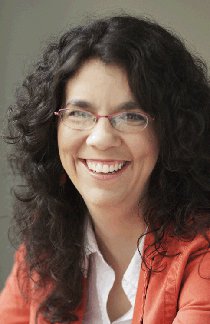 Rachel Hartman, the April 28 guest in Augustana College's River Readings at Augustana series, is the author of the 2012 young-adult novel Seraphina. It's a fantasy tale of royalty and knights and the faraway kingdom of Goredd; of a mysterious murder and supernatural powers and fanciful beings named Loud Lad and Pelican Man.
Rachel Hartman, the April 28 guest in Augustana College's River Readings at Augustana series, is the author of the 2012 young-adult novel Seraphina. It's a fantasy tale of royalty and knights and the faraway kingdom of Goredd; of a mysterious murder and supernatural powers and fanciful beings named Loud Lad and Pelican Man.
More specifically, it's a story of the 16-year-old girl of Hartman's title, a gifted music instructor who's harboring a bit of a secret: She's not actually a girl. Or rather, she's half-girl, and half-dragon. And she's hardly the only dragon in town.
It turns out Goredd, as we learn on the book's eighth page, is a kingdom where dragons are able to assume human form, even if they don't have much understanding of, or use for, human emotions. Yet if you ask Hartman how she landed on the idea for Seraphina, and for her transformable creatures in general, she'll no doubt admit that inspiration didn't come from mythology or legend or previous works of fiction. It came from an inability to illustrate dragons.
"I started out doing mini-comics," says the Vancouver, Canada-based Hartman during our recent phone interview, "and there's one issue that has me drawing a dragon, and it's just ... . It's awful. I can't even tell you. It's just so stupid-looking. It looks like a kangaroo with fangs. So it came to me that if dragons could turn into humans, then I could draw humans, and then I could be super-lazy ... which is my whole goal in life."
Laughing, she continues: "But what ended up happening, which I hadn't anticipated, was that all these questions were raised. Because if dragons could take human form, then the person sitting right next to you could be a dragon, and how would you know? And if you were a dragon, were you obligated to tell anybody? And then I thought, 'Okay, there are gonna have to be rules for this society so they [dragons and humans] can get along, and a history,' and this sort of thing.
"So yeah. It was just inadvertent. An act of laziness was the biggest idea-generator that I've ever had. Ever."
As acts of laziness go, Hartman's has hardly been an unpopular or unprofitable one. A New York Times bestseller that debuted at number eight on the periodical's Children's Chapter Book rankings, Seraphina was the recipient of 2012's Cybils Award for best young-adult fantasy or science-fiction novel and 2013's William C. Morris Award for best young-adult work by a debuting author. Its success has also, as might be expected, created demand for a sequel, which Hartman has titled Shadow Scale, and which is set for publication next March.
Seraphina is also, in this middle-aged author's opinion, a helluva fun read for adults, evocatively and excitingly and sometimes quite humorously written, and boasting characters and narratives that keep you engaged through the entirety of its 464 pages (including its "Cast of Characters" and "Glossary" sections, both of which are helpful and amusing in their own rights). It's the sort of unexpectedly gripping novel in which, as I did, you intend to read 50 or so pages before bed, and finally turn out the lights 150 or so pages later.
"Fantasy has always been my very favorite genre," says Hartman. "And, really, books for kids, as well. I feel like one of the reasons I wrote a young-adult novel instead of an adult fantasy novel is because that was the age when reading was the most magical to me. When a single book still had the power to change your whole life."
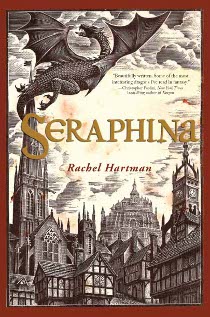 Kicking and Screaming Out of the Children's Section
Kicking and Screaming Out of the Children's Section
A native of Lexington, Kentucky, and the daughter of a college-professor father and visual-artist mother, Hartman recalls being engulfed in the magic of literature from early childhood. "During summer vacations, my mother used to have to, like, throw me out of the house. But I figured out that if I took a book and went outside before she could throw me out ... . I was not, shall we say, athletically gifted in any way, so reading was sort of my alternative there."
Yet by her teen years, Hartman's tastes in reading material, as she admits, hadn't much changed. "My parents would have to drag me kicking and screaming out of the children's section of the library. They said, 'No, no, you have to read grown-up books now,' and the ones that appealed to me were fantasy, because that most resembled what I had enjoyed as a child. So I started reading Tolkein and that sort of thing.
"In college," adds the graduate of Washington University in St. Louis, "I did have sort of a hiatus where I decided, 'Okay, I really do have to read adult books.' And I gave it my best shot. I loved Latin American magic realism. But fantasy has always been my favorite."
As far as Hartman's career goals were concerned, "My very first aspiration, according to my mother, was to be a fire hydrant. That didn't work out so well.
"I thought about being an anthropologist. I thought about being a historian. But what I finally figured out at university was that I wasn't so much interested in history as I was interested in history as a story, you know? I mean, my favorite history teacher in high school - he was really good at this - would make American history into a story to the extent that every day you wanted to go back to class and find out, like, 'Who won the Civil War?!?'"
She laughs. "Like we didn't know. But that's the kind of compelling storyteller he was. And so I kind of mistook loving the story for loving history."
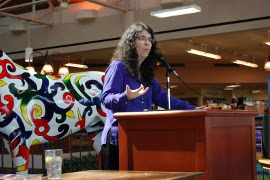 Hartman settled on a degree in comparative literature, which she calls "sort of a catch-all thing for all these classes I'd taken." But she opted against graduate school in favor of pursuing new interests - namely, comic strips and graphic novels.
Hartman settled on a degree in comparative literature, which she calls "sort of a catch-all thing for all these classes I'd taken." But she opted against graduate school in favor of pursuing new interests - namely, comic strips and graphic novels.
"I was reading the student paper," says Hartman, "and I turned the page, and there was this ad that said, 'See your comic strip here. Call ... .' And it was like being hit by lightning. All of a sudden, I was like, 'A comic strip! I have to do that! That is the thing I always wanted to do that I had no idea I always wanted to do!'"
Her school-paper comic strip, a "classicist humor" serial titled Ellen of Troy, ran for two years, and led to 10 years as a mini-comic author and illustrator that culminated in the 1996 debut of her self-published serial Amy Unbounded. (The comics' individual installments were subsequently collected in graphic-novel form.) A fantasy that first introduced readers to Seraphina's kingdom of Goredd, Amy Unbounded also served as the figurative birthplace of Hartman's miraculous dragons - and, more significantly, Hartman's professional career.
"I received a Xeric Grant for self-publishers," she says of Amy Unbounded's origins, "and got it distributed by comic distributors, and so I actually made money. At least, I didn't go into this hideous debt, which was kind of amazing.
"But it was hard. I mean, it was no way to make a living. I was working at bookstores, too. And I was married, which helped," she says with a laugh. "But financially, I wasn't qui-i-ite pulling my weight in the household. And I was about 30, and I had just had a baby, and so I was like, 'You know what? It's time to start writing seriously.'"
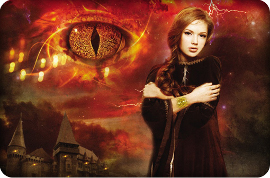 The Myths of Goredd
The Myths of Goredd
For her first attempt at a fantasy novel, Hartman knew she wanted to keep writing about Goredd, a kingdom she had actually been writing about for a long, long time.
"You can really dial it all the way back to seventh grade," says the author. "I was assigned a narrative poem in English class, and I wrote this poem, which was very silly, called 'The First Adventure of Sir Amy.' It was about a little-girl knight, and she lived in the kingdom of Goredd - because it rhymed with 'Fred,' which was the name of her horse, you see?"
With a laugh, Hartman continues, "It wasn't very fleshed out, but there were dragons, and there was a king named King Kiggleworth, who later became [Seraphina character] Prince Lucian Kiggs. And then in high school, I would write stories on my own, and I would set them in Goredd. I had a mythology class where I had to make up myths, and they were all the myths of Goredd.
"So this had been building really slowly. And now, it's become really handy, because it's sort of a visual guide. Any time I'm writing and I get kind of stuck in trying to picture things, I can look at Goredd in the comic and say, 'Oh, right!'"
She also wanted to continue writing about her shape-shifting creatures, as she became more and more intrigued by the question "What would it be like for a dragon in human form?"
Hartman says, "Like, dragons in dragon form - surely they must have really good eyesight. They're hunters. But I bet they don't have much sense of touch. And their sense of hearing, probably, would not connect to emotional centers like ours would. So how disorienting would it be for dragons to find themselves in human form, and suddenly be bombarded with all this sensory information they weren't used to handling?
"And from the senses," she continues, "it was just a sort of hop, skip, and jump to emotions. Because, surely, that's also a messy, mammalian thing that reptiles aren't going to need for their social structure, such as it is. I know from having raised a child that we're not born knowing what to do with our emotions. And so how does a dragon handle emotion coming into our world as an adult, and never having experienced emotion before?"
(Regarding her Seraphina dragons' natural talent for mathematics, Hartman says, "Well, in my life, I've found that people who are a little less emotional are also really good at math. My husband's a physicist, so I have this mathematical dragon in my house all the time. But don't tell him that. He thinks the prince was modeled on him, and I just let him think that.")
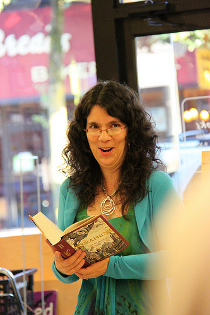 Yet even armed with a ready-made setting and fascinating fantastical characters, Hartman says that it still took "about nine years to write" Seraphina.
Yet even armed with a ready-made setting and fascinating fantastical characters, Hartman says that it still took "about nine years to write" Seraphina.
"The first plot I had was actually a very quiet one. It was just about Seraphina and her father, like, not getting along," she says, laughing. "And I sent the book out to agents, and they'd send me notes back saying, 'Oh, you write really well ... and if you ever figure out what a plot is, look me up.'
"So I spent months and re-wrote it with a better plot, and was able to get an agent that way. But he sent it out, and the first person he sent it to, at Simon & Schuster, said, 'You know, this plot sort of has two arcs. What if we divide the book into two and make each arc its own book? Then you've got a two-book deal!' So I expanded the first half into its own book, and I sent it to her, and I waited and waited and waited. And then the first thing I hear back, after about nine months, is that this person had left Simon & Schuster."
Eventually, after many months of continued revisions, Seraphina landed at Random House. "And my Random House editor said, 'You know what? I love your writing, I love the world, I love the characters ... but the plot has got to go.'" (It's at this point in our interview that Hartman lets out a comically agitated "Aa-a-a-a-a!!!")
"So I finally say, 'Okay, you know what? I've written this book three times now, and I can't write it again. So here's what I can do. I'll write the next book.' The second arc. And that's what I did. That's what Seraphina is - the next book. And I don't think that first one is ever gonna see the light of day. I think I just had to let it go.
"It's one of those really funny things," says Hartman about Seraphina's consequent success, "where everyone treats you like you came out of nowhere, and you're the overnight sensation ... and you know it took nine years to write the thing, you know? There's this dissonance there. To go from endlessly toiling at this task - being Sisyphus pushing this thing up the hill again and again - to having this thing that people love really kind of did a number on my head. Suddenly, there were thousands of people for me to disappoint with this next book."
Regarding her follow-up Shadow Scale, Hartman is understandably hesitant about revealing details, except to say, "I started the sequel before Seraphina actually came out, and have been writing it for three years now. And it's been really hard. I went through some depression, because I had to get back to a place where I was writing because I loved it, and not because people were expecting me to write this thing. I can't write unless I can get back to a place where it's at least engaging enough to keep me in my chair."
And, as must be asked in our era of Twilight, The Hunger Games, and Divergent, is there any chance of a Seraphina movie on the horizon?
"Oh, golly," says Hartman. "In my dreams. So far not, but I would love to see somebody's interpretation of it. That would tickle me."
Just don't expect Hartman to take on the screenwriting duties herself. "I think that would jut drive a stake right through my heart," she says with a laugh. "No. I think I know my limitations as far as external pressure goes."
Rachel Hartman will read from and discuss Seraphina at Augustana College's Center for Student Life (639 38th Street, Rock Island) on Monday, April 28, at 7 p.m. Admission is free, and more information is available by calling (309)794-7316 or visiting Augustana.edu.
For more information on the author, visit RachelHartmanBooks.com.










